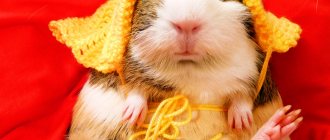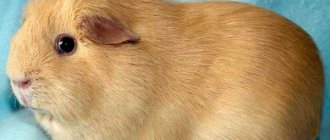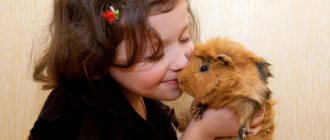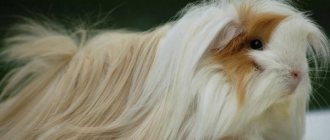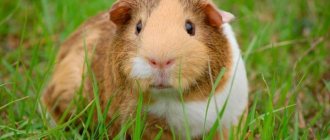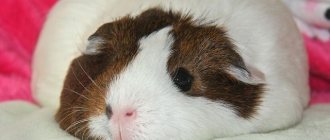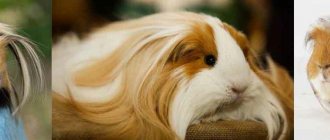- home
- Guinea pig
- General information about guinea pigs
02/14/2019 Guinea pigs have a unique appearance and calm character, which is why they have become favorite pets. But many owners do not know the details of the origin of these animals or the features of their physiology. New information will allow you to better understand your pet and the motives for its behavior.
Historical facts
The most interesting fact about guinea pigs is the origin of the name. Initially, they were called “overseas”, because they were brought from abroad. Over time, the first part of the name disappeared, leaving only “sea”. These rodents are wary of water and, with rare exceptions, are reluctant to take baths.
The English name - Guinea Pig, comes from the old English currency - the guinea. This is exactly how much one individual cost in Europe as soon as America was discovered, from which these strange animals were brought. In the 16th century this amount was considered decent, and the owners of such animals were considered wealthy.
Peru is considered the homeland of the animals, where they were first domesticated to be used for meat production. Breeding for agricultural production still occurs - there are special meat breeds of these animals. The animals were also considered quite valuable to be used as sacrifices to the ancient gods.
In some tribes, such as the Mochiko, pigs were considered sacred animals. They made sacrifices and worshiped them. The image of rodents served as a central element in the works of art created by representatives of this tribe.
Underwater rocks
Is it difficult to care for a guinea pig? People who think that smaller animals require less attention than dogs and cats are mistaken. Cages (and often the area around the floor) require constant cleaning. The animals are quite sensitive to air temperature, drafts, stress and quality of food. Long-haired guinea pigs need to be brushed to prevent tangles from forming. Hair matted in clumps can cause real suffering to the animal. Establishing contact is also not easy. Young children will likely not wait many days while taming a pig before holding it. Consequently, the animal will not be happy about this. In addition, some animals never get used to such games and tenderness - this largely depends on their individual characteristics.
Guinea pigs do not like to be alone. They need a companion of their own species with whom they can “talk” , play, or just sit next to them. Communication is so important to their well-being that Switzerland has made it illegal to have just one pig. And if you get pigs of different sexes, one will have to be castrated.
Physiology
Pigs reach puberty by two months. Cubs are carried for an average of 60–63 days. The peculiarity is that the animals are born already formed: they see, hear and are completely covered with fur. And a few hours after birth, they are already able to move around the cage independently.
The animals' diet is varied. In addition to dry food, the diet includes vegetables and herbs. However, not all products are safe. Before feeding, you should study the list of permitted and prohibited foods so as not to harm the animal.
What is known about guinea pigs is that they periodically eat their own excrement. This happens because a large amount of vitamins K and B remains in the primary feces. To avoid vitamin deficiency, pets instinctively eat waste. Therefore, it is better for owners to buy a cage without a special tray: in this case, the pet will not be able to eat excrement and will begin to suffer from a lack of vitamins.
The teeth of pigs, like those of many rodents, grow continuously throughout their lives and need to be constantly ground down. For this purpose, the animals are provided with wooden products or mineral stones. If this need is ignored, the teeth grow and prevent the animal from eating, which leads to exhaustion.
The pet must follow a feeding schedule. His intestines are designed in such a way that food passes through it only with the help of the next portion of food. In the absence of a second portion, stagnation forms in the gastrointestinal tract.
Features of guinea pigs
Guinea pigs have large and round eyes, so they have a very good-natured look. And this impression is not deceptive. You can even buy such a pet for children. Unlike rats and large hamsters, pigs rarely bite. There are exceptions, but only if the creature is severely tortured. Their distinctive feature is good nature and calmness. Another advantage: guinea pigs are active during the day, so the owners are not in danger of waking up from the noise in the cage. The greatest activity in pigs occurs in the morning and evening.
There are about a dozen different breeds of guinea pigs, which can be classified by their fur, or... lack thereof. They can be divided into four main groups:
- Angora is a guinea pig with long hair;
- Standard - short-haired, with soft fur;
- Wire-haired – the coat feels like bristles;
- Skinny - hairless guinea pig
Behavior and habits
The animals are most active at night. During the day, they fall asleep several times for 10 minutes and remain awake the rest of the time.
These pets are known to love the company of their own kind or other animals. Therefore, as a rule, they are purchased in pairs. When alone, the animals try to “call” their relatives, making different sounds: squeaking, rumbling, squealing. But even in society, pets remain noisy. Voice messages play an important role in everyday life. With the help of a variety of sounds, they convey information to others. For example, cubs squeak to attract their mother's attention. Thus, the animal communicates with the owner and “trains” him to respond to certain signals in an appropriate way.
The following facts about guinea pigs for children will be interesting: these animals are friendly and suitable as pets for young owners. Despite their sharp claws and teeth, pets rarely turn them against their owners.
What kind of cage does a guinea pig need?
Guinea pigs need a lot more space than most people think. Miniature cages for hamsters and birds will not work here. Experts recommend choosing a “living space” of at least 0.7 square meters per animal. Large cages cannot always be found in the nearest store, but it is quite possible to buy them on the Internet, make them to order, or assemble them yourself. This house should be located in a quiet, secluded place away from large pets and drafts. There should also be no direct sunlight. The bedding in the cage is made from standard fillers of shavings, paper or hay - the same as for other rodents. Do not use softwood shavings (such as pine or cedar) as they are toxic to guinea pigs.
There must be a house in the cage. To make the animal feel even more comfortable, part of the “enclosure” can be closed from above.
Records
The lifespan of pets depends on the conditions of detention, but on average reaches 5–7 years. The oldest individual lived to be 15 years old.
Despite their dense body mass, pigs are able to run fast. The record was recorded by an English animal named Flash, who covered a distance of 10 meters in 8.81 seconds.
Guinea pig facts regarding records:
- Scottish pig Truffle demonstrated the longest long jump - 48 cm.
- Pukel, an animal from Switzerland, jumped 20 cm in height.
- The maximum number of cubs in one animal pregnancy reached 17.
The cunning of the priests
One of the witty versions of why rodents from South America in Europe were classified as marine animals is associated with the peculiarities of monastic life. According to church beliefs, eating meat awakens base passions and voluptuousness in a person. Therefore, in addition to bread, cereals, beans and herbs, the monks were allowed to eat (with very rare exceptions) only fish. However, many were unable to withstand all the hardships of monastic life on bread and water alone.
A similar trick was later applied to the guinea pig, because there were many monasteries in Germany, Spain, and France.
Interesting information
- Guinea pigs live from 5 to 7 years. For comparison, mice, rats and hamsters live about two years.
- These rodents sleep for only 10-15 minutes several times a day. They may fall asleep with their eyes open.
- The height of an adult animal can reach from 20 to 25 centimeters in length, and weight from 800 to 1200 grams. As a rule, males are slightly larger than females.
- Despite having fangs and claws, guinea pigs do not like to bite or scratch. Although if you make them angry, they may bite.
- They are herbivores. These rodents are very fond of vegetables, fruits, berries and herbs.
- Pigs are born with open eyes and short hair.
- The antibiotic penicillin is poisonous for these animals; do not try to treat them yourself, because this antibiotic is part of many antibiotics.
- Rodents' teeth grow throughout their lives.
- Despite the fact that pigs are mammals, the body of an adult is not able to digest lactose (milk can cause indigestion).
- The body of pigs is not able to reproduce vitamin C on its own; it must receive it from food.
Origin story
In prehistoric times, Josephoartigasia monesi (ancestor of guinea pigs) reached a height of 1.5 m and 3 m in length, and weighed more than 1000 kg! Such animals bit much harder than tigers. Modern wild pigs jump well and even swim, climb rocks and tree branches, they are much more agile than their domesticated relatives. In the wild, guinea pigs form packs, where several dozen females are led by a male leader.
About 7 thousand years ago, an Indian people in the Andes (South America) managed to domesticate the guinea pig. The exact name of the tribe that domesticated these rodents has not been preserved. Today it is the territory of Peru, Bolivia, Ecuador and Colombia. At that time, the tender meat of rodents was eaten and used for ritual and even medicinal purposes.
The scientific name of Cavia porcellus is Latin for “little pig.” From the language of the Galibi tribe, the word cabiai was borrowed and transformed into cavia. Foreign breeders use the term Cavy (Cavey or Cavey), and in Russia the name “guinea pig” is widely used.
Communication
Even though animals are not able to speak with words, they communicate with each other using sounds. Guinea pigs, like many other animals, are fairly easy to understand. And they themselves quickly learn how to make the “breadwinner” understand their needs.
For example, pigs sniffling means that they are anxious or waiting. If this sound is interspersed with a whistle, most likely the pet is asking for food.
Rumbling has many meanings; for a more accurate interpretation, it is necessary to take into account the posture. A satisfied, relaxed pig purrs with happiness. If the tone is higher, and the movements are tense or the animal is trembling, this indicates irritation. Animals that are scared make abrupt rumbling sounds. Animals that feel angry grind their teeth and open their mouths, like lions when they roar.
With closer contact, the sounds of guinea pigs and their movements become clear to the owner, so do not regret the time spent with your pet.
Breeding
Breeding rosette pigs has its own nuances. The gene that is responsible for the formation of spirals and the rigidity of the cover is dominant. When mating two representatives of the breed, offspring without rosettes may appear if the recessive allele for smooth hair (r) is present in the genotype of both parents.
In addition to the rosette gene, an important role is played by the genetic modifier marked M. If it dominates, then the formation of correct rosettes is suppressed even in the presence of the rosette gene.
In such pigs, instead of normal spirals, the following are formed:
- combs only;
- curls on wool;
- only 2 sockets and one comb.
If the modifier gene is in a recessive state (marked mm), then rosettes of the correct shape are formed. In fact, to breed good pigs, a superficial knowledge of their genetics is not enough. Under the influence of various factors, even purebred animals can produce descendants that are far from perfect.
The rosette pig is mated with a male at the age of 4-10 months, if it weighs more than 700 g. Estrus occurs every 16-20 days. The most favorable time for fertilization is the first 6 hours of sexual heat. It is advisable for the male to make several cages during mating games, then the likelihood of pregnancy will be higher.
The rosette guinea pig carries its young for 63-66 days. There are 3-4 piglets in a litter, less often – up to 6. The more babies in the womb, the shorter the gestation period. The first birth can last 2-3 hours, each subsequent one occurs faster. Rodents are born at intervals of 5-7 minutes.
Caring for rosette pigs cannot be called difficult. Rodents are unpretentious, so they won’t cause much trouble. In response to the care and love of their owner, they will willingly give a lot of positive emotions.
Great pets for your home
Many people keep guinea pigs as pets because they are truly cute and friendly little creatures. The more we interact with them, the more they trust us. If guinea pigs sit on your lap, they will often begin to purr and even fall asleep if you care for and pet them.
Some more fun facts:
- In the wild, guinea pigs live in social groups called “colonies.”
- Pet guinea pigs need plenty of attention and love to develop into friendly, lovable pets.
- Guinea pigs are very sensitive to loud noises
- When a guinea pig stretches, it shows that it is relaxed and happy.
- When they are happy, guinea pigs often jump up and down
- Guinea pigs cannot produce vitamin C in their bodies on their own, so they need a diet that contains sufficient amounts of this vitamin.
